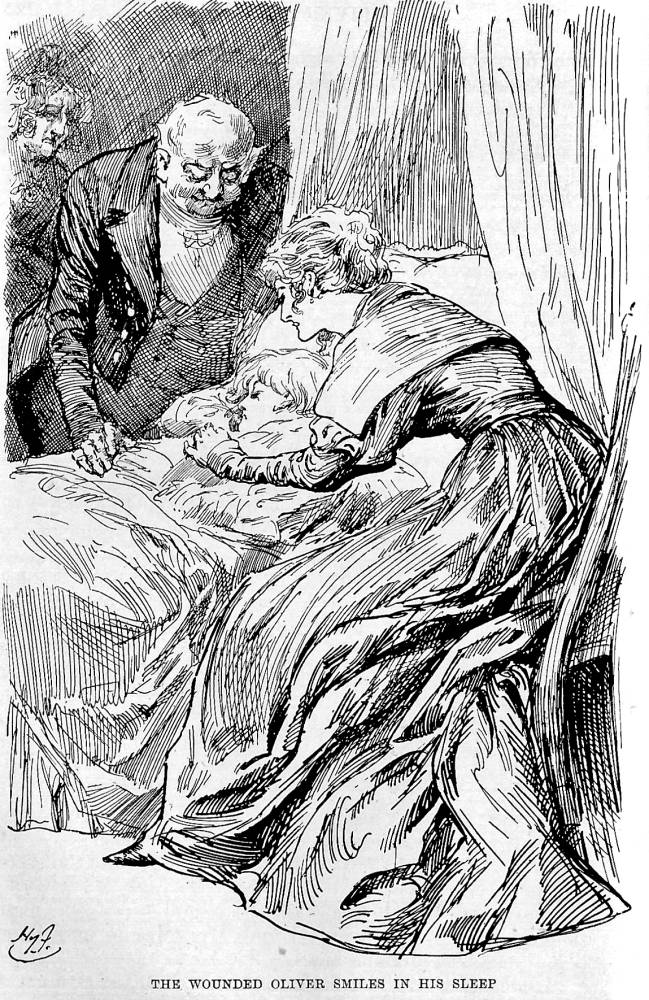All images except the first are taken from our own website. [Click on them to enlarge them, and for more information about them where available.]

Talia Schaffer's exploration of the response to chronic illness in the Victorian novel is very much on trend. In literary studies disability has become a fully-fledged subject for critical investigation, and in our everyday lives we are still discovering the long-term effects of the Covid pandemic, both for those who contracted the virus, and for society as a whole. We therefore recognise many of our own interests, needs and dilemmas as Schaffer shows how ongoing health problems affect not only those characters in need of care, but also those who offer it. The contrast between Oliver Twist's heartless treatment in the workhouse and the loving-kindness shown to him at the Maylies' home, even before his connection with them is known, at once suggests where the patient's own best interests lie. Schaffer describes Oliver's experience with the Maylies as "paradisal" (74). Acknowledging that the realities of offering such care may be taxing, Schaffer still sees how rewarding it can be, enriching the affections, the family circle, and even society in general. Looking at Victorian fiction from this point of view, she hopes to provide Eve Kosofsky Sedgwick's idea of "reparative reading" — an approach that aims to restore the past to a new generation of readers — with a more rigorous methodology, and to suggest its application to the general practice of literary criticism.

Oliver Smiles in His Sleep by Harry Furniss.
Among the other novels that Schaffer looks at in her "careful" way are Charlotte Brontë's Jane Eyre. Here, the institution of Lowood School fails so markedly that Helen Burns's only comfort comes from her young friend, who crawls into bed with her on the night she dies. Later, Jane herself benefits from such a personal attendance, when the Rivers family rallies round her after her flight from Thornfield Hall, "laying the basis for lifelong bonds" (84). These episodes come to mind readily, but there is much in between that also benefits from reparative reading, so that the reader does, indeed, come to see this as a useful critical tool. Another example is George Eliot's Daniel Deronda, in which the dying Mordecai's "community of care" (130) is the Cohen family. Mordecai in turn "brings a blessing down" on them (qtd. 130) — and an even greater one on Daniel himself. Schaffer goes on to show how Mirah, with whom Daniel embarks on his future, having first been helped by the Meyrick family, is also helped by Mordecai. What Schaffer calls a thorough-going "care reading" helps to reveal the ways in which both these young people, after surviving their difficult pasts, emerge from "damaging passivity" and "relearn viable social relationships through Mordecai" (133).

Charles Copeland's illustration of George Eliot's Daniel Deronda with Mordecai, facing p.308 — "this ardent suffering creature" will strengthen and guide the eponymous hero (Eliot 308).
Such reciprocity sounds ideal, but, as Schaffer reminds us, caring within the community was never that straightforward. Her historicism comes into full play as she investigates the drift in the nineteenth century from traditional domestic care to institutionalised care, not just for orphans and others without means of support, but for those who were too much of a burden for their families, or who needed more specialist treatment and help. This often meant turning from female attendance to male professionals, and from a holistic approach to medical interventions. As Schaffer says, "novels of the 1840s may have been the last ones to unproblematically assume that ordinary bodies required care communities" (83). While care recipients themselves might then miss out on the emotional benefits of being lovingly attended, those who would otherwise have looked after them were losing the emotions engendered by this attendance. We of course are the heirs to these developments.
The clock cannot be turned back, but Schaffer shows that focussing on "social relationality and action instead of individual psychology and deep motives" can give us useful insights into what is happening in individual novels (2). As promised in her introduction, she makes what she terms "care ethics" a basis for "a theory of reading.... a lens through which to view relationships, behaviors, and persons" (2). She operates on several fronts, as she says herself, but two stand out. As a literary critic, she offers fresh and thoughtful entries to a range of works, including, in her later chapters, Henry James's The Wings of the Dove, in which the consumptive heroine, Milly Theale, is seen as a paradigm of living (or, rather, dying) without care, and Charlotte Yonge's The Heir of Redclyffe. In her discussion of the latter, Schaffer concludes by looking at the ending of the novel, and at the complex care community around Guy Edmonstone's daughter, Mary, and her godparents: the "new community formed around her and her needs" seems to render her "a living merger of the mythic and domestic," which perhaps, Schaffer suggests, is how Yonge "wanted her own authorship to work" (186). Both these novels are as subtly probed as the earlier ones, and, in showing how the novelists engage their readers, Schaffer engages her own readers, too.
This helps her on the second, more practical front: she often looks up from the page at the social and political ramifications of her subject. While sustained attention to these would have been outside the scope of her book, Schaffer does find occasion to train her "lens" on the support groups formed, for example, in queer communities, and the types of kinships established among Black and indigenous people. Talking about social media in particular, she pleads for society as a whole to co-operate in reparative work, so that we can "see each other as subjects to whom [we] could extend care" (20).
How far does Schaffer succeed in her stated aims? She herself is the first to acknowledge that literary critics cannot hope to change public agendas, however thoughtfully they draw on the humane visions of the past. Her theoretical and thickly citational approach will not travel well out of academe. Here, her most useful immediate effect will be on literary criticism, through the angle she adopts in her close readings of her chosen novels. But her final chapter, in which she pleads for care and respect in research, analysis and reviewing, is also inspiring, and may well have its quiet effects. As she points out, scholarly citations themselves are a sign of thinking and consolidating ideas as a community, since "each citation co-exists in a dialogue with the others.... The academic essay is a network that holds multiple writerly voices simultaneously in suspension" (208). Few will close this book without recognising the important role played by caring in Victorian novels — and without resolving to make more effort to practice it themselves, both inside and outside academe.
Links to Related Material
- Metropolitan Convalescent Hospital, Walton-on-Thames
- Review of Hosanna Krienke's Convalescence in the Nineteenth-Century Novel: The Afterlife of Victorian Illness
Bibliography
[Book under review] Schaffer, Talia. Communities of Care: The Social Ethics of Victorian Fiction. Princeton, New Jersey: Princeton University Press. Hardback. £75.00. IBN: 978 0 69119963 4.
[Illustration source] Eliot, George.
Created 4 August 2023